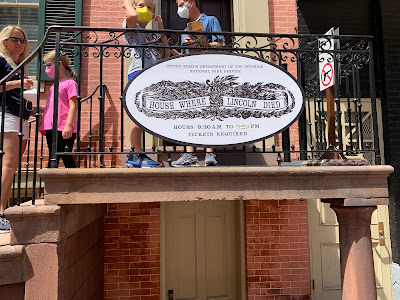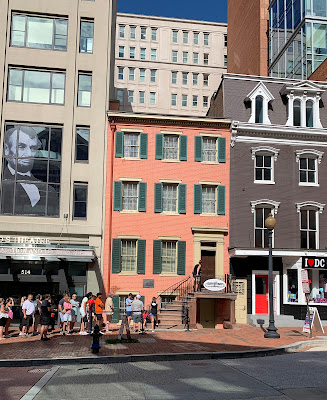Today was Sunday so we decided to visit Washington D.C. since parking would be easier. The downside was the Daughters of American Revolution Museum and Library is closed on Sundays so we wouldn't be able to visit. But the bonus when we arrived was not only is parking easier, it was FREE! No meter to feed! And even better - we were able to park around the corner from Ford's Theater, the place where Abraham Lincoln was assassinated.
We got our tickets and were glad we came early on a Sunday morning because even at this time, we had an hour wait.
At the appointed time, we entered the theater and were able to take our time through the museum. It's amazing there is a photo of the theater from sometime between 1862-1875. Lincoln was assassinated in 1865.
A few of the artifacts that we found interesting.
This is the gun that John Wilkes Booth used to kill the President.
There was controversy as to whether the gun should be displayed.
This is Booth's Door Wedge. A pine bar, from a wooden music stand, used by John Wilkes Booth as a wedge to keep the outer door to the presidential box closed after his entrance.
On January 31, 1865, Lincoln used his influence to secure passage of the Thirteenth Amendment to the Constitution abolishing slavery throughout the United States. Five weeks later the president took the oath of office a second time. The sun came out from the clouds as he delivered the famous words, invoking the Almighty in justifying the long war, even as he appealed for a peace "with malice toward none, with charity for all".
Abraham Lincoln, Inauguration, March 4, 1865
This toy sword belonged to Thomas "Tad" Lincoln III, the fourth and youngest son of Abraham and Mary Todd Lincoln. The nickname Tad was given to him by his father who thought he had a large head and was "as wiggly as a tadpole" as a baby. Tad was known to be impulsive and unrestrained, and he did not attend school during his father's lifetime. He had free run of the White House and there are stories of him interrupting presidential meetings, collecting animals, and charging visitors to see his father. He died unexpectedly of an illness at the age of 18 in 1871 in Chicago.
The Lincolns had lost two of their four sons, Eddie and Willie, prior to Abraham Lincoln's death. A third, Tad, died six years after his father was assassinated. Only the oldest, Robert, lived to adulthood. Robert was the Captain who was with General Ulysses S. Grant in Appomattox when General Robert E. Lee surrendered.
Willie Lincoln
Upon Abraham Lincoln's death, Mary Lincoln wanted her husband's body to take the most direct route home to Springfield, Illinois for burial. But, Secretary of War Edwin Stanton convinced her to approve a more circuitous railroad journey that retraced the whistle stops Lincoln had made from the Illinois capital to the national capital four years earlier.
As dawn broke on April 21, 1865, the clopping of hooves broke the silence as horses drew the hearse carrying Lincoln's black mahogany coffin from the U.S. Capitol, where it had spent the prior two nights lying in state, to the nearby Baltimore and Ohio Railroad station. Gripping the coffin's silver handles, soldiers carried Lincoln's body onto the presidential railroad car, which featured luxurious crimson silk upholstery and walnut and oak finishing. Consumed by war, Lincoln never had a chance to see the newly constructed railcar, let alone ride in it.
Inside the funeral car, the presidential coffin joined a smaller one that contained the body of his son, Willie, who had died from typhoid three years earlier at the age of 11. His casket had been held in a vault in a Georgetown cemetery awaiting interment in Springfield at the end of Lincoln's presidency, which no one envisioned would end so prematurely.
An example of the train car that carried the two coffins, as well as 150 passengers, approximately 1,700 miles through the country. Mary Lincoln was too distraught to leave the White House and did not board the train.
And then we were on to the "main event", the theater where Lincoln was assassinated on April 14, 1865.
The balcony box where Mr. and Mrs. Lincoln, as well as Major Henry Rathbone and his fiancee Clara Harris (daughter of U.S. Senator Ira Harris of New York) sat. Ulysses S. Grant and his wife, Julia, were originally going to join the Lincolns but declined because Julia Grant and Mary Lincoln were not on 'good terms'.
The president was sitting on the red chair (reproduction)on the right
The guide explained that when the chair was removed from Ford's Theater, it was taken to the Smithsonian and was housed in a closet. In the late 1800's, workers at the museum were apparently using the chair during their breaks and hair oil was damaging the upholstery. It is now housed at the Henry Ford Museum in Greenfield Village, Michigan.
A builder, now-deceased craftsman Carlton McLendon from Montgomery, Alabama, was commissioned to build a replica chair. He felt bitter toward the Union because two of his Confederate ancestors died in the conflict.
Initially, McLendon resisted several requests by the Department of the Interior to build the chair but eventually relented and added a sly bit of unofficial interior decorating - a Confederate flag sewn into the seat. The rumor about the flag had persisted for many years but they recently examined the chair and found it to be true.
And the entrance to the box where John Wilkes Booth entered in order to assassinate the president.
And after the guide spent more than 30 minutes telling us the specifics of the night, we exited the theater and walked across the street to the Petersen House, a boarding house which was the only place nearby where they could take the dying president.
It was surreal to walk inside the house, even though there were very few original artifacts.
A period piece showing the bed where Abraham Lincoln died at 7:22 a.m. on April 15, 1865.
A photo of the bedroom and bed at the time of his death. This is the room where Secretary of War, Edwin Stanton, stated as Lincoln took his last breath "he now belongs to the ages".
There was even one of the pillows that the president was lain on, showing the blood left behind. The pillow is currently on display at the Ford's Theater Museum across the street.
There were many people in the Petersen House throughout the night.
And then it was time to take the President back to the White House, less than 4 hours after his death.
Of course, we all know that John Wilkes Booth was the assassin but after an investigation, it was found there was a conspiracy to kill the President.
John Wilkes Booth, circa 1860
The conspirators.
There is way too much information about the conspiracy to add to this blog post. In fact, there is so much information about Abraham Lincoln in print and it was on display in the Petersen House Museum where all of the books written about him are stacked in a tower.
The day was only half over and we still had much to see. Stay tuned.





























I am a big Lincolnphile (no such word, I know), but have never been there despite being in DC many times. It's definitely on my bucket list.
ReplyDeleteWe were there about 25 years ago - it is SO much better now!
Delete